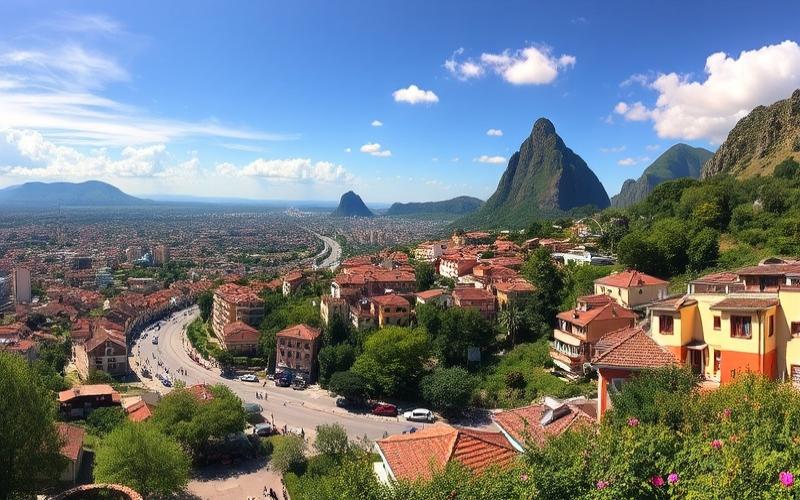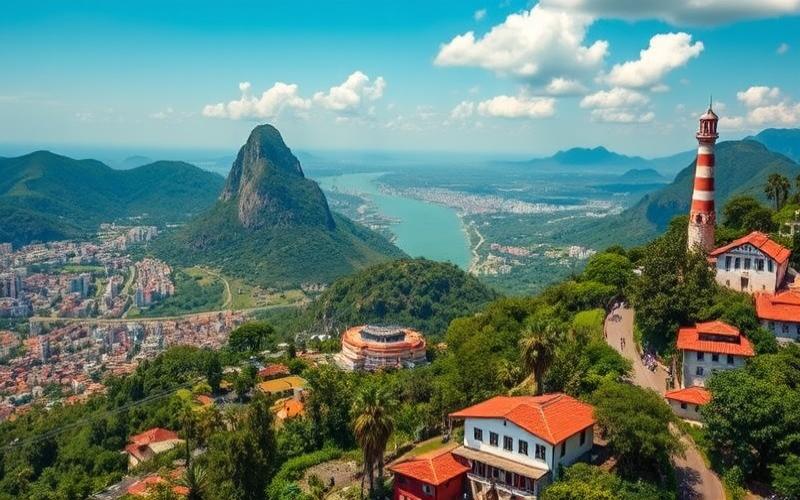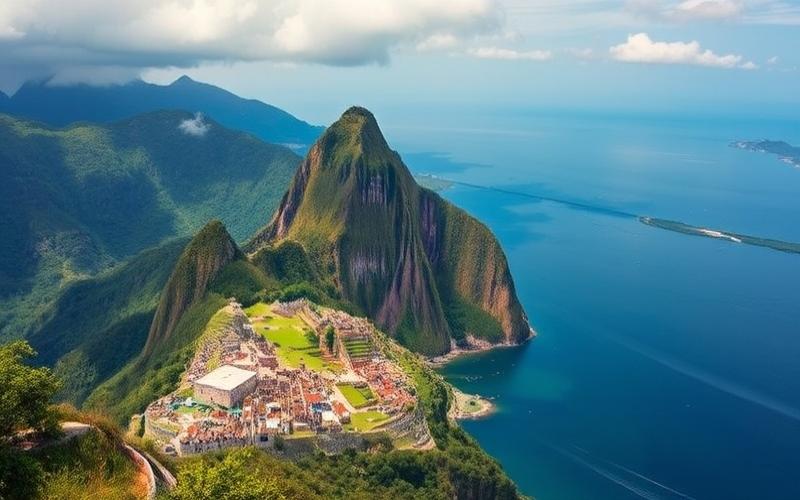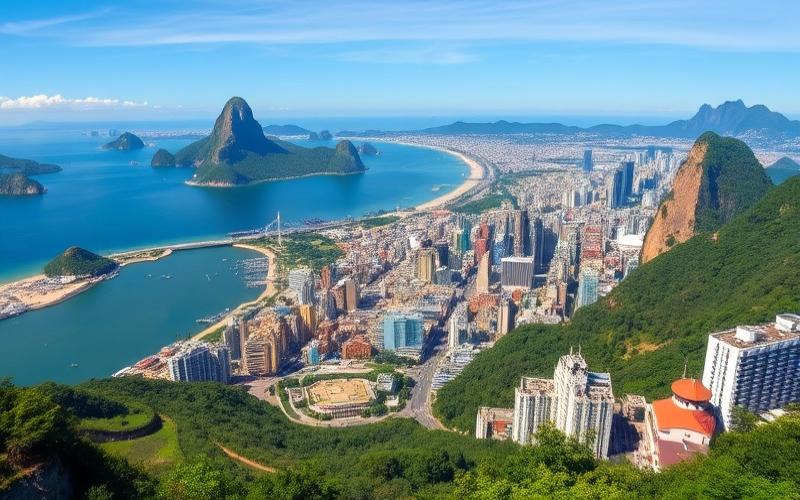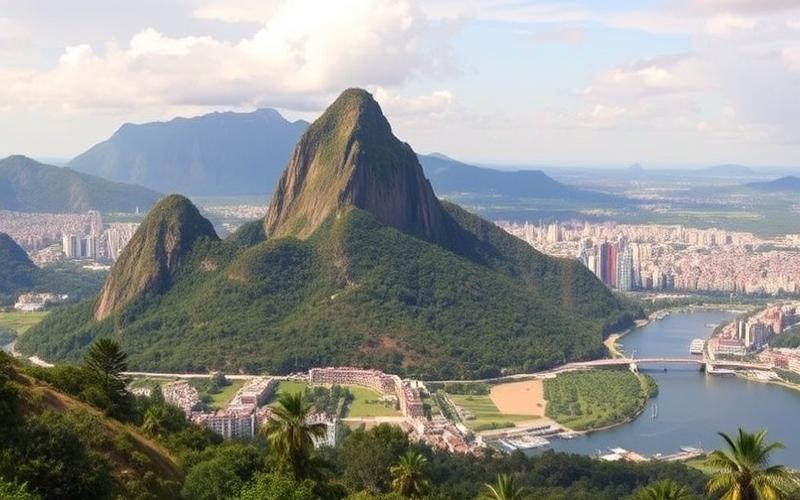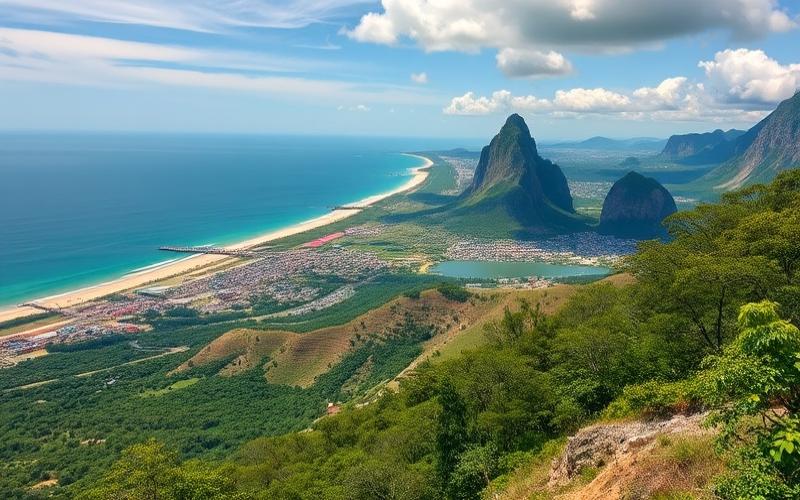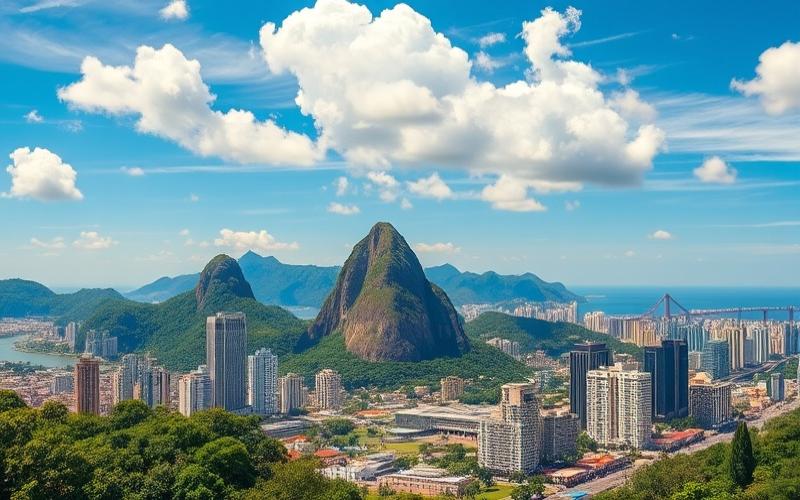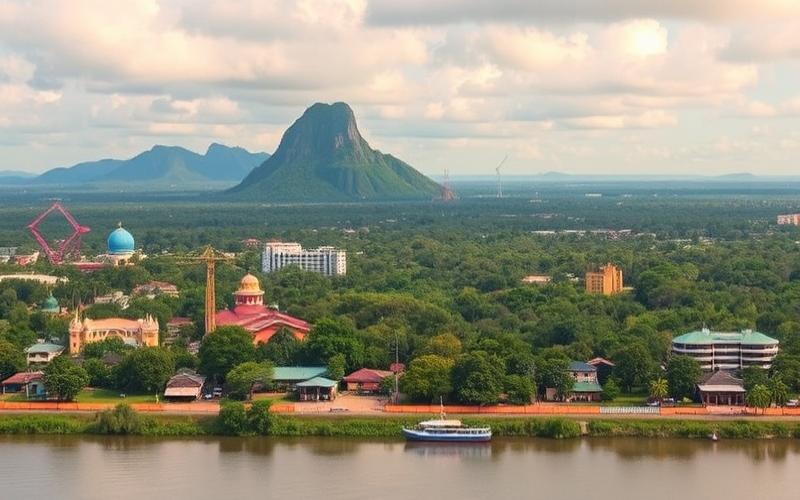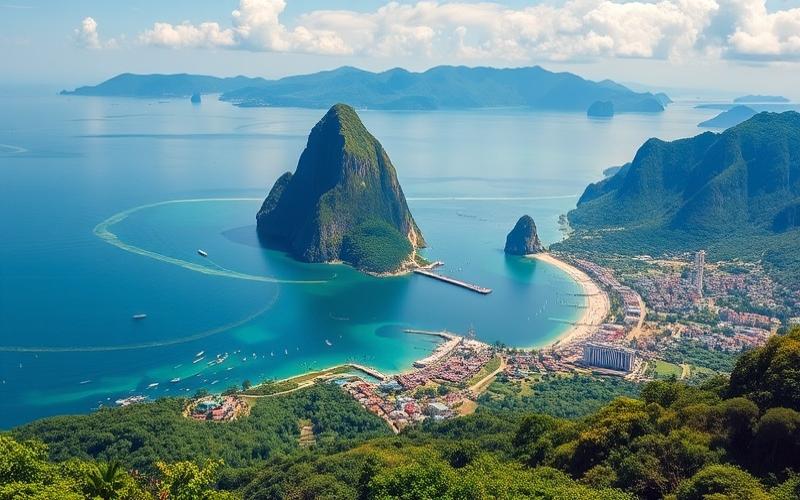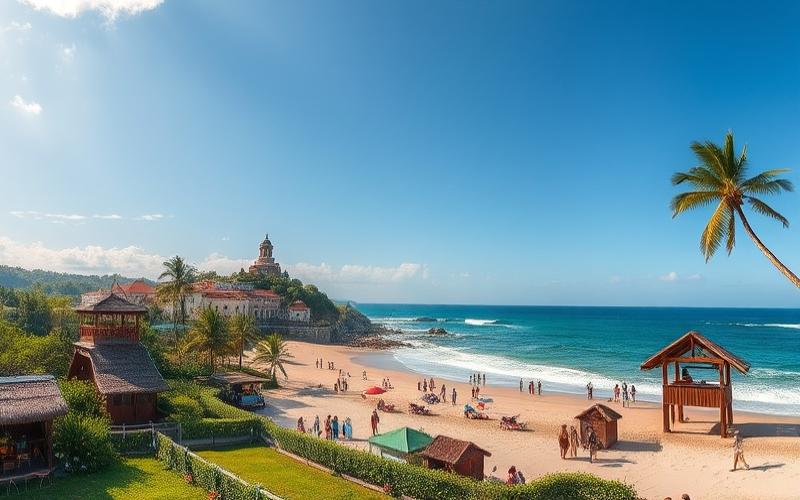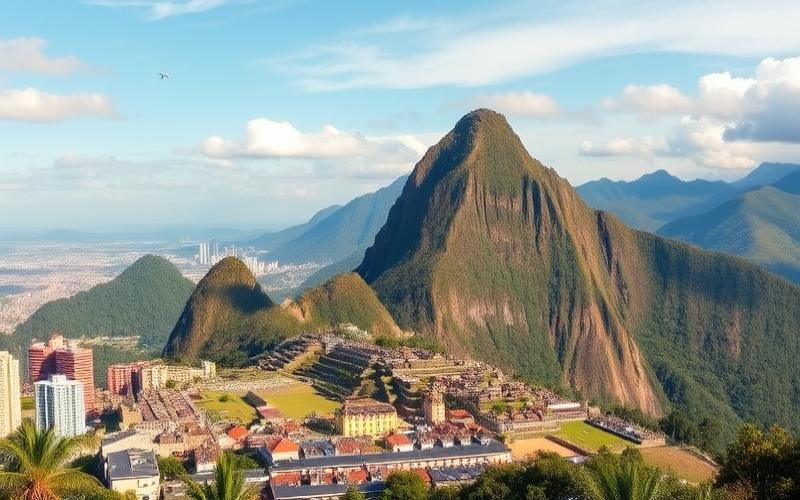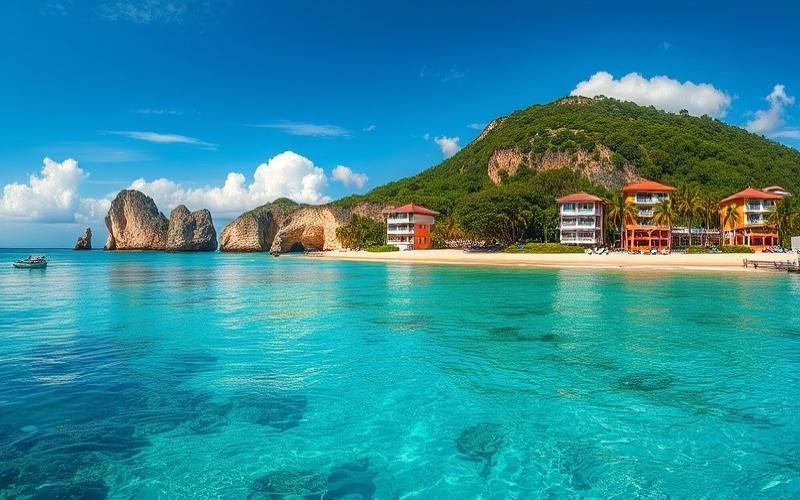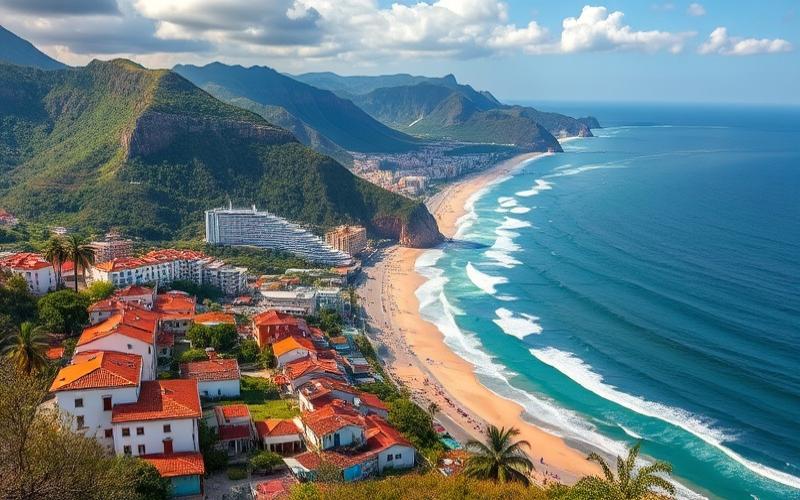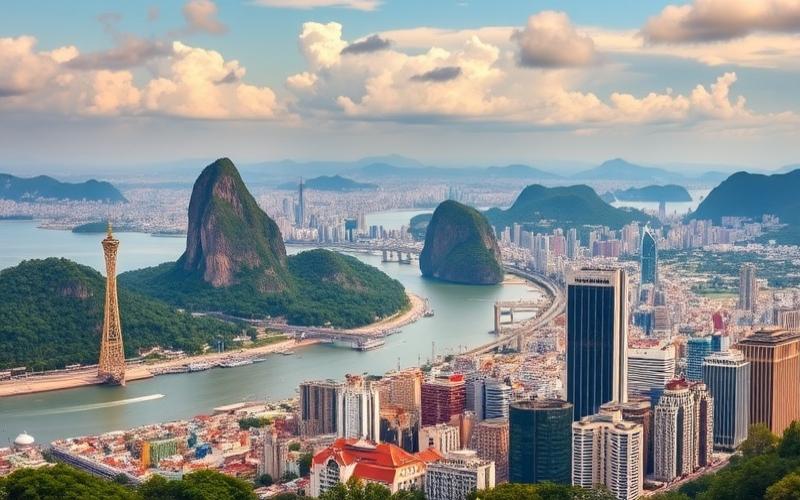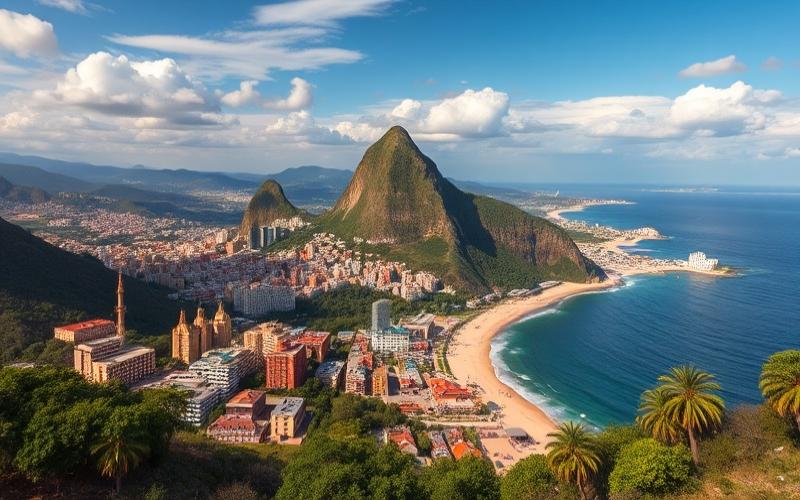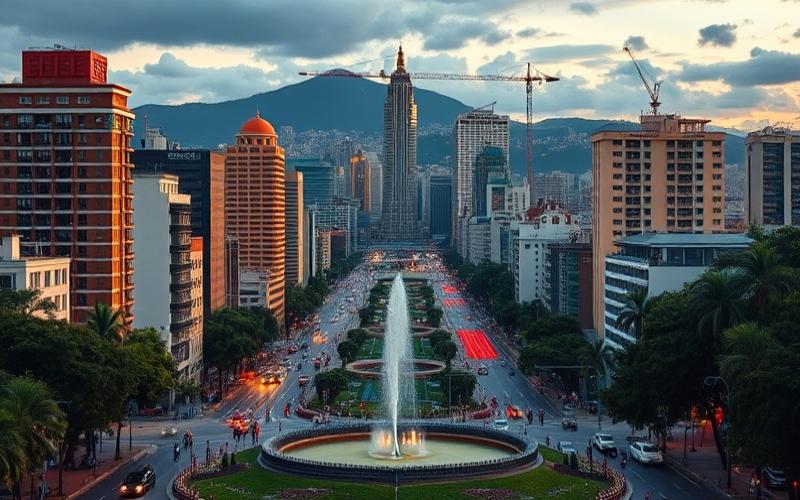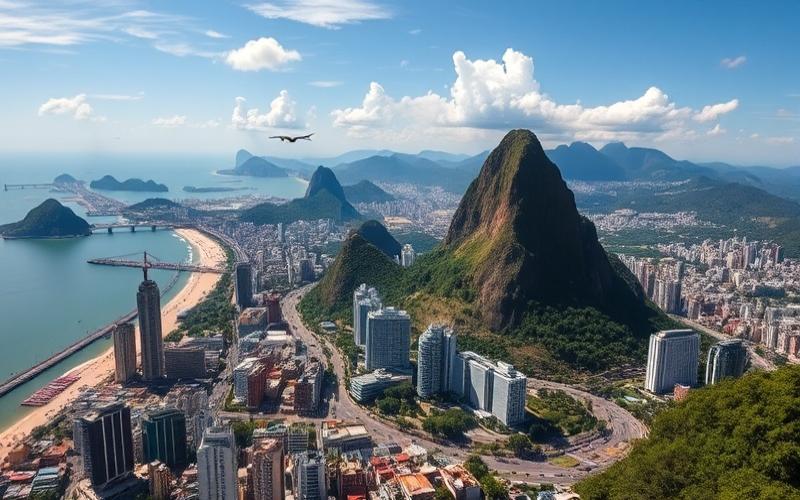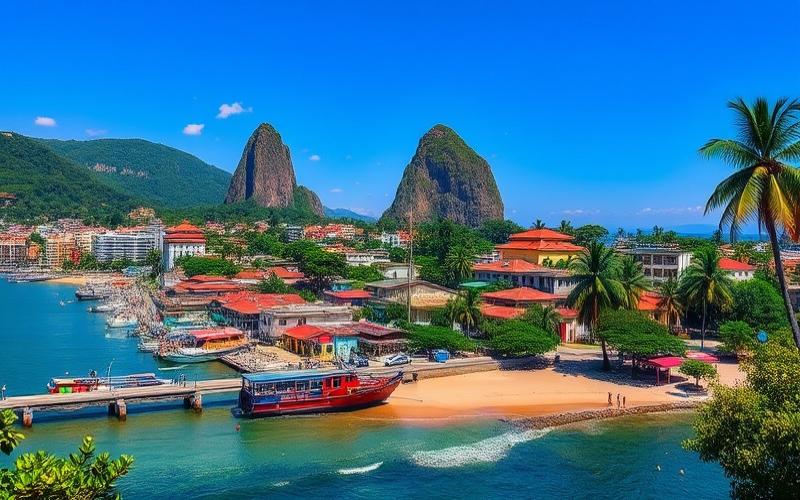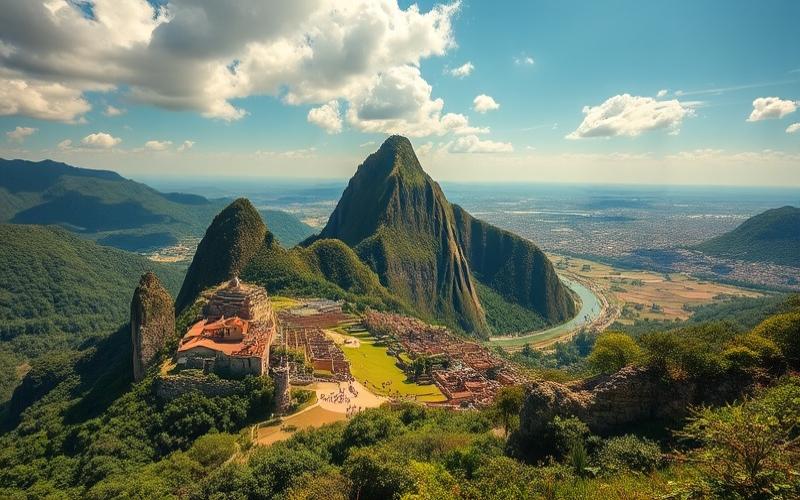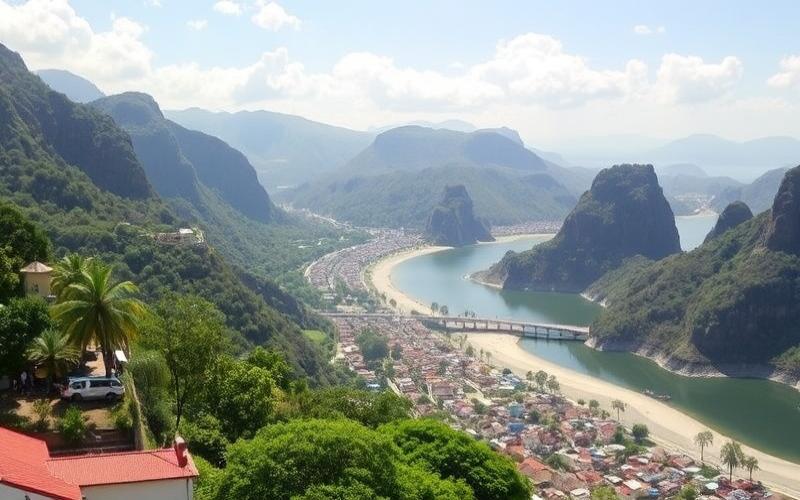
 Published on and written by Cyril Jarnias
Published on and written by Cyril Jarnias
Brazil: Pioneering Green Real Estate in the Face of Environmental Challenges
In response to growing environmental challenges, Brazil is establishing itself as a major player in the field of green real estate, adopting bold measures to meet the demands of sustainable development.
By 2025, the country is intensifying its efforts by implementing strict environmental standards while offering attractive subsidies to encourage the construction and renovation of eco-friendly buildings.
These initiatives aim not only to reduce the carbon footprint of urban infrastructure but also to stimulate the economy by creating jobs in the sustainable building sector, making Brazil an inspiring example on the global stage.
Good to know:
Green real estate represents a major economic opportunity for Brazil, combining sustainable development with economic growth.
Green Building Standards in Brazil
The main green building standards in force in Brazil are structured around ABNT technical standards (NBR), energy and environmental performance codes, and private certification systems like LEED and AQUA-HQE that shape the market, particularly in the private sector and among major developers. They target reduced energy and water consumption, lower CO₂ emissions from material life cycles, improved indoor air quality, and climate resilience, with growing emphasis on material decarbonization and low-carbon industrialization in the construction sector.
National Technical Standards (ABNT NBR)
ABNT NBR 15575 (Residential Building Performance)
Objective: define performance levels (safety, habitability, durability), including acoustic insulation, water tightness, natural lighting, and thermal efficiency.
Technical specifications: performance-based approach (not just prescriptive), reference lifespans by element, on-site and laboratory testing, and minimum/intermediate/superior performance levels.
Market impact: catalyzes quality and durability in housing, especially in social and affordable housing programs, and serves as a reference for private investors seeking to secure long-term value.
ABNT NBR 15220 / 16401 (Building Thermal Performance and HVAC)
Objective: thermal and energy performance according to Brazil’s bioclimatic zones, sizing and efficiency of air conditioning systems.
Specifications: thermal load calculation methods, envelope criteria (inertia, insulation, solar factors), cooling equipment efficiency requirements, ventilation and air quality.
ABNT NBR 5626 / 15527 (Water)
Objective: cold water systems, and rainwater reuse for non-potable purposes.
Specifications: sizing, materials and backflow prevention devices, storage, treatment, and health quality controls.
ABNT NBR 16747 / 16280 (Inspection, Renovation and Work Management)
Objective: periodic inspection, maintenance, control of modifications in condominiums, to extend durability and reduce failures.
Specifications: maintenance plans and responsibilities, technical documentation and traceability.
ABNT NBR 16690 / Material Standards
Objective: performance and safety requirements for structures, concrete, and industrialized components.
Specifications: encouragement of prefabrication and industrial control, favorable to quality, timelines, and material efficiency in collective housing projects.
Energy Performance Codes and Instruments
Building Energy Labeling/Benchmarking
Objective: classify energy performance (envelope, systems, hot water) and stimulate renovations and bioclimatic design.
Specifications: methodologies adapted to hot-humid, mixed, and hot-dry climates, integrating natural lighting and ventilation.
Related Public Programs
Minha Casa, Minha Vida
Impact: dissemination of performance and durability requirements in mass housing, with growing pressure on material and process efficiency, and attention to the carbon footprint of the cement and tile sectors.
Relevant Certifications and Labels in Brazil
LEED (Leadership in Energy and Environmental Design)
Objective: assess overall environmental performance (site, water, energy, materials, IAQ).
Technical specifications: energy modeling (adapted ASHRAE), commissioning, measurement and verification, credits for operational CO₂ reduction and material carbon content, construction site and waste management.
Brazilian context: very present in commercial buildings, corporate headquarters, and large-scale projects targeting international standards of attractiveness and investment.
AQUA-HQE (Brazilian adaptation of the HQE framework)
Objective: environmental management of operations and 14 targets (energy, water, waste, hygrothermal/visual/acoustic comfort, IAQ).
Technical specifications: management system approach and measurable performance, strong focus on indoor air quality, water and occupant health, certification audits in Brazilian context by local body.
Brazilian context: widely adopted by residential and office developers seeking fine integration with local practices (materials, climates, usage).
Other Labels in Use
EDGE (IFC) for resource-efficient buildings in emerging markets, focused on energy, water and material embodied energy savings.
WELL (occupant health and wellbeing) often complementing LEED/AQUA on premium projects.
Material and Value Chain Labels (e.g., FSC for wood, EPD/LCA for ceramic products and cement), rising with the sector’s decarbonization strategy.
Technical Specifications and Implementation Trends
Envelope and Comfort
Bioclimatic strategies by zone (solar protection, natural/hybrid ventilation, adapted inertia).
Solar factor criteria, U-values of walls, thermal bridges and air tightness adapted to hot climates.
Systems
Chiller efficiency, variable speed, heat recovery, BACS/BMS for control.
High-efficiency LED lighting, daylighting and sensors.
Water and Resilience
Rainwater and greywater reuse, low-flow fixtures, leak detection, green roofs for heavy rain management.
Materials and Carbon
Lower-clinker concrete, cement additives (slag, ash), optimized ceramics, EPD and LCA.
Industrialization/prefabrication to reduce waste, timelines and variability, promoting concrete and steel efficiency.
Construction Site and Life Cycle
Waste management plans, traceability, optimized logistics, commissioning requirements and post-delivery measurement and verification.
New Standards and Revisions Expected by 2025 and Impacts
Strengthening Material Decarbonization
Cement and ceramic sectors investing in clinker reduction, kiln energy efficiency and EPD integration, driven by markets and institutional buyers.
Expected impact: lower carbon footprint of structures and finishes, greater transparency via product LCA.
Rising Operational Energy Performance Requirements
Extension and update of labeling schemes and calculation references to better reflect actual usage (air conditioning and humidity) and integrate distributed renewables.
Expected impact: more projects targeting measured energy intensity goals (kWh/m².year), and dissemination of measurement and BMS systems.
Standardization of Water Reuse and Extreme Event Management
Clarification of health requirements for greywater and rainwater, sizing for extreme rainfall and heat islands.
Expected impact: widespread adoption of retention/infiltration systems, and reduced pressure on networks.
Low-Carbon Industrialization and Prefabrication
Acceleration of structural and envelope prefabrication with industrial quality control to reduce waste and material intensity.
Expected impact: reduced timelines, stabilized costs, lower concrete/steel consumption and better repeatable performance.
Governance and Regulatory Constraints
Risk of tensions between administrative simplification objectives and environmental safeguards, potentially impacting permitting procedures and environmental protections for some projects.
Expected impact: regulatory uncertainty for green project developers and need to align with voluntary standards (LEED/AQUA/EDGE) to secure funding and acceptability.
Alignment with Brazil’s International Commitments
Nationally Determined Contributions (NDC) and Net Zero
Sectoral alignment on CO₂ emission reductions, via building energy efficiency, cement material decarbonization and rise of distributed renewables.
Private initiatives and international frameworks (LEED, EDGE, AQUA-HQE) serve as implementation and verification instruments aligned with international best practices.
Sustainable Development Goals (SDG)
SDG 6 (water and sanitation), SDG 7 (clean energy), SDG 9 (industry, innovation), SDG 11 (sustainable cities), SDG 12 (responsible consumption/production) and SDG 13 (climate action) are directly mobilized in the cited standards and certifications, with emphasis on expanded access to sanitation, energy efficiency and urban resilience.
Sustainable Finance and Attractiveness
Demand for climate-aligned assets and investor taxonomy pushes adoption of certifications and LCA/EPD data, facilitating access to capital and private tenders, while demonstrating contribution to emission reduction goals.
Operational Considerations for Developers in Brazil
- Choose a main framework: LEED, AQUA-HQE or EDGE according to typology, budget and investor expectations.
- Audit NBR 15575 compliance from schematic design; integrate ABNT bioclimatic zoning.
- Require EPDs for high carbon intensity materials; target low-clinker concrete.
- Integrate water reuse and extreme rain management from design phase.
- Plan for commissioning, measurement and verification, and BMS to achieve kWh/m².year targets.
- Evaluate prefabrication to control costs/timelines and reduce material footprint.
By 2025, Brazil’s green building trajectory is driven by the combination of NBR performance requirements, low-carbon industrialization, and massive adoption of voluntary certifications (LEED, AQUA, EDGE), with expected impacts on material CO₂ reduction, measured energy performance and water management, despite regulatory uncertainties linked to simplification reforms.
Good to know:
In Brazil, the main green building standards include LEED (Leadership in Energy and Environmental Design) and AQUA (Alta Qualidade Ambiental), which value energy efficiency, sustainable resource use and occupant quality of life. These certifications aim to reduce buildings’ ecological footprint through strict criteria. By 2025, new standards will be introduced, such as the revision of RTQ-R (Technical Regulation of Quality for Residential Buildings), which will further integrate renewable technologies and low-carbon emission materials. These developments align with Brazil’s international commitments, such as the Paris Agreement, for substantial carbon emission reduction and increased promotion of sustainable development in the construction sector. The new standards are expected to encourage broader adoption of green practices, thus catalyzing a greener real estate market.
Subsidies for Renewable Energy
Renewable energy has become a central lever for “green real estate” in Brazil in 2025, as it reduces building operating costs, decarbonizes portfolios and aligns with new federal directions favoring decentralized, low-carbon production. Recent reforms (financing via green bonds and sectoral tax incentives) accelerate the integration of solar, wind and biomass solutions in real estate projects, especially in high-potential regions like the Northeast.
Types of Available Subsidies and Incentives
- Subsidies and bond financing for decentralized solar production linked to real estate consumers (rooftops, solar carports, shared solar farms), enabled by Law 14,801/2024, with long maturities suitable for real estate assets.
- Tax incentives and dedicated legal framework for low-carbon industrial chains and green hydrogen, driving renewable electricity demand and green PPAs for industrial and logistics real estate sites.
- Green credit lines via local investment banks to refinance solar plants powering multi-site real estate portfolios (“decentralized production” model).
- Regional development programs in the Northeast favoring deployment of renewable energy infrastructure connected to industrial zones and logistics parks.
Eligibility Criteria (Main Expectations for Developers and Owners)
- Compliance with decentralized production framework and ability to contract PPAs/self-consumption agreements for buildings or multi-asset portfolios.
- Project financial solidity and financing vehicles rated/structured for long term (credit requirements for bonds or bank refinancing).
- Technical compliance: integration of certified systems (solar PV, potential micro-wind depending on zoning, local biomass) and connection compliant with distribution rules for shared generation.
Organizations Involved in Financing
- Federal authorities and legislature: adoption of Law 14,801/2024 opening broader access to bonds and instruments for decentralized renewable energy projects.
- Brazilian investment banks and capital markets (e.g., Itaú BBI) structuring long-term issuances and refinancing.
- Energy companies and private developers (e.g., GreenYellow) operating solar plants for real estate clients via long-term contracts.
- National and regional public authorities promoting fiscal and industrial frameworks to attract low-carbon projects and green electricity demand.
Recent Policies and Initiatives
- Law 14,801/2024: new financing framework for decentralized renewable energy production, facilitating bond issuances backed by solar assets and their deployment for real estate sites.
- Tax incentive framework and legal security for green hydrogen enacted in 2024, catalyzing low-carbon industrial investments and associated renewable electricity consumption.
Examples and Case Studies
- Bond issuance of 85 million BRL (16-year maturity) for five decentralized solar plants spread across multiple states (BA, SP, MT), refinancing investments and ensuring long-term visibility for real estate consumers via green energy contracts.
- Accelerated development of low-carbon industrial zones (e.g., Pecém complex) attracting international companies and creating renewable energy demand covered by incentives and dedicated frameworks, stimulating associated logistics parks and real estate.
Trends and Forecasts 2025
- Acceleration of “decentralized production + green bonds” structures to equip commercial rooftops, retail parks and warehouses with solar via multi-asset contracts.
- Rise of green PPAs in industrial zones supported by H2V incentives, favoring energy certification of real estate assets and green leases.
- Strengthened role of local investment banks in long-term refinancing of solar plant portfolios dedicated to the real estate sector.
- Regional dissemination in the Northeast, where energy transition policies attract capital and projects, positively impacting industrial real estate values and absorption.
| Energy Type | Dominant Support Mechanism | Common Real Estate Use in 2025 | Financial Horizon |
|---|---|---|---|
| Solar PV | Bonds/decentralized financing (Law 14,801) | Commercial rooftops, retail, warehouses, shared farms | Long term (up to ~16 years) |
| Wind (onshore) | Regional/industrial incentives and PPAs | Powering industrial/logistics parks via PPAs | Medium-long term |
| Biomass/biogas | Targeted incentives according to local sectors | Agro-industrial sites and park cogeneration | Medium term |
To maximize access to subsidies and financing in 2025, developers should prepare: a portfolio of sites eligible for decentralized production, connection and self-consumption studies, a solid credit structure (SPV/issuance vehicle), and energy contracts aligned with regional fiscal frameworks.
Good to know:
In 2025, Brazil is emphasizing renewable energy to strengthen green real estate, with subsidies targeting the integration of solar, wind and biomass systems. Developers can qualify for these aids by complying with certain environmental and energy performance standards. Federal agencies like ANEEL, as well as some banks, facilitate financing, often in collaboration with private entities. Recent initiatives include the extension of the Programa de Incentivo às Fontes Alternativas de Energia Elétrica to broaden access to green financing. Projects started in São Paulo and Rio de Janeiro already show reduced energy costs. For 2025, these measures are expected to increase the share of renewables in new construction by 30%, marking a decisive turn for green real estate in Brazil.
BREEAM Certification in Brazil
BREEAM certification is gaining popularity in Brazil, driven by the rise of “green real estate”, interest from international investors, and pressure from corporate tenants in the financial, technology and industrial sectors for more performant and resilient assets. It fits into a global trend of tightening environmental assessment standards and alignment with decarbonization goals, with heightened performance thresholds by 2025, particularly in energy, carbon, water and circular materials.
BREEAM Integration into Brazilian Frameworks
BREEAM integrates complementarily with local environmental requirements, strengthening existing Brazilian frameworks:
- Local frameworks: energy efficiency standards (e.g., PBE Edifica labeling), building thermal performance codes, municipal construction waste management requirements, and environmental impact study obligations per environmental legislation.
- National and municipal policies: net zero strategies towards 2050, urban climate plans (GHG inventories, low emission zones), permeability and stormwater management requirements, growing integration of ESG criteria in public tenders and concessions.
- Complementarities: BREEAM structures the “whole-life carbon” approach (embodied + operational), climate resilience, urban biodiversity, health and wellbeing, and circular economy, providing traceability and third-party verification sought by investors.
Common BREEAM-Certified Building Types and Projects in Brazil
- Prime offices and corporate headquarters.
- Shopping malls and retail parks.
- Logistics and industrial warehouses (including last-mile).
- Hospitality and high-end multifamily residential.
- Educational institutions and private healthcare assets.
- Major renovations and fit-outs of existing assets.
Main Criteria to Meet for Certification
(weightings vary by scheme):
- Energy and operational carbon: envelope performance, high-efficiency HVAC systems, active management, commissioning and measurement/verification.
- Life cycle carbon: material LCA, embodied carbon reduction, reuse/re-purposing, recycled content, environmental product declaration.
- Water: consumption reduction, efficient equipment, greywater and rainwater reuse, leak detection.
- Materials and circular economy: responsible sourcing, demountable design, construction waste management plan, reuse targets.
- Transport: public transport accessibility, active mobility, EV infrastructure, mobility plans.
- Pollution and resilience: indoor air quality, NOx reduction, heat island management, adaptation to climate risks (floods, heat, extreme events).
- Biodiversity and land: ecological plans, permeable surfaces, green corridors, native planting.
- Health and wellbeing: natural light, acoustics, thermal comfort, views, safety and inclusivity.
- Management: project governance, stakeholder consultation, commissioning, post-occupancy monitoring.
Impact on Sustainable Development and Energy Savings in Brazil
- Measurable reductions in energy demand and operational emissions, via envelope-systems optimization and commissioning, and rise of heat pumps and photovoltaics.
- Decreased potable water consumption and discharges, thanks to reuse and efficient equipment, relevant facing urban water stress.
- Acceleration of material circularity, reduction of construction waste and embodied carbon through LCA and reuse.
- Co-benefits: improved indoor air quality, occupant productivity, asset climate resilience and financial valuation (eco-performance premium, liquidity).
2025 Subsidies and Financial Incentives for Adopting Sustainable Construction Standards
including BREEAM-compatible:
- Municipal tax incentives (exemptions or reductions of IPTU/ISS) conditioned on environmental performance or recognized green certification, with progressive scales according to performance level.
- Green credit lines with preferential rates via BNDES, public and private banks, for energy efficiency, on-site renewable energy and deep renovations.
- Utility programs (energy efficiency) and sectoral “white certificate” mechanisms, financing audits, HVAC/lighting equipment modernization and active management systems.
- Municipal/state climate project calls supporting de-impermeabilization, stormwater management and urban biodiversity, compatible with BREEAM credits.
- Facilitated access to sustainable financing (green bonds, sustainability-linked loans) with BREEAM-compatible KPIs (energy intensity, operational carbon, reuse rate), reducing cost of capital.
- Constructibility bonuses and fast-tracking in some jurisdictions for projects meeting verified environmental performance thresholds.
Summary Table — BREEAM Integration into Brazilian Context
| Element | Common Local Requirement | BREEAM Contribution | Project Benefit |
|---|---|---|---|
| Energy | Labeling and efficiency codes | Envelope + systems optimization, commissioning, M&V | Lower OPEX, lower GHG |
| Water | Rational management and reuse | Reduction targets, water recovery, leak detection | Water resilience, targeted CAPEX |
| Materials | Construction waste management | LCA, reuse, responsible sourcing | Less embodied carbon |
| Transport | Urban mobility plans | EV, cycling, proximity to public transport | Fewer commute-related emissions |
| Biodiversity | Permeability/urban trees | Ecological plans, native species | Microclimatic comfort |
| Resilience | Climate risk maps | Risk analysis, adaptation | Operational continuity |
Best Practices List for Targeting “Excellent/Outstanding” Level
- Conduct early LCA and set carbon budgets for structural work and finishes.
- Prioritize high-efficiency HVAC systems (heat pumps) and very low U-value envelope.
- Integrate rooftop/façade PV and storage according to load profile.
- Implement BMS with sub-metering by usage and optimization algorithms.
- Design for reuse: modularity, demountability, material passports.
- Deploy rainwater and greywater reuse for non-potable uses.
- Document indoor air quality, acoustics and natural lighting from design phase.
- Schedule commissioning, post-occupancy monitoring and performance commitment.
In 2025, obtaining a high BREEAM certification in Brazil is a strategic lever: it aligns projects with local climate policies, improves energy-water-carbon performance, facilitates access to sustainable financing and may qualify for tax or urbanistic benefits, strengthening asset value and resilience.
Good to know:
BREEAM certification is growing in popularity in Brazil, effectively integrating with local environmental requirements and government policies. Primarily adopted for office projects, luxury residential buildings and shopping centers, BREEAM assesses aspects such as water management, energy efficiency and overall ecological impact. Certified projects must meet rigorous criteria in terms of carbon emission reduction and sustainable resource use. In 2025, the Brazilian government offers various subsidies and financial incentives to encourage green real estate, particularly projects aligned with BREEAM, to promote sustainable development and energy savings. These incentives include tax reductions and financing facilities, making sustainable construction more accessible and attractive for real estate developers seeking to comply with these international standards.
State Aid for Greener Real Estate
The main state aid available in Brazil in 2025 for greener real estate combines public credit lines with preferential rates, concessional financing via development banks, and targeted tax incentives at federal and state levels, with growing emphasis on climate resilience and energy efficiency. These mechanisms rely particularly on international partnerships (BRDE–AFD) that broaden access to green capital with grace periods and improved conditions.
Key 2025 Measures and Subsidies
- Green credit lines from public and development banks:
- BRDE (Southern region) backed by AFD financing: cumulative envelope raised to €340M, with new lines providing up to 3 years grace period for projects by companies, public actors and SMEs integrating sustainability.
- AFD instruments in Brazil: sovereign/non-sovereign loans, guarantees and co-financing for low-carbon urban development, climate resilience and territorial transformation, mobilizing local financial system to accelerate Agenda 2030.
- Tax incentives and local support:
- States and municipalities deploy tax benefits and exemptions targeting efficient buildings and water/sanitation/waste infrastructure within sustainable urban agendas supported by international donors.
- Environmental permitting reforms, although controversial, are accompanied by a dynamic of infrastructure concessions and logistics corridors, where climate and energy efficiency criteria are integrated into tender documents.
- Subsidies/bonifications linked to urban services:
- Strengthening of water and waste operators (e.g., investment movements in the Northeast) fits into efficiency improvement and carbon footprint reduction programs, supported by development financing.
Flagship Initiatives and Preferential Rate Loans
- BRDE–AFD Partnership 2025: new €120M tranche dedicated to sustainable urban projects and adaptation, with concessional conditions (grace period up to 3 years), reducing cost of capital for energy renovation, solar rooftops, water management, and green certifications in commercial and residential real estate.
- AFD financing for low-carbon cities: 2025 priorities covering inclusive urban development, resilience, and mobilization of financial intermediaries to channel green credit towards sustainable construction and thermal rehabilitation.
Role of Public Policies and Impact for Owners/Developers
National sustainability policies and climate agenda (focus on COP30) direct investment flows towards energy-efficient real estate assets, by conditioning access to cheaper capital and accelerated permits for projects aligned with environmental standards.
Waves of concessions and urban modernization create a pipeline of private/PPP projects where energy efficiency and water saving requirements become differentiators to win tenders, which improves bankability of green real estate projects.
Concrete Examples of Projects Utilizing These Aids
- Sustainable smart neighborhoods: Smart City Natal (25,000 housing units, smart energy and waste management, delivery until 2035) illustrates the orientation of financing and incentives towards real estate complexes integrating energy efficiency and circular economy.
- Regionally funded programs via BRDE–AFD: portfolio for companies, cooperatives and public actors in Southern states supporting building energy renovations, public lighting modernization and water management with improved credit conditions.
Usual Eligibility Criteria
- Climate alignment:
- Measurable contribution to emission reduction, energy efficiency, on-site renewables, sustainable water and waste management, and resilience (e.g., floods/heat).
- Regulatory compliance:
- Compliance with local environmental standards and obtaining environmental licenses per reformed procedures, with enhanced ESG due diligence in concessions.
- Financial and technical capacity:
- Robust business plan, performance indicators (kWh/m², water savings), and implementation capacity demonstrated by developer or partner ESCO; SME eligibility for some lines.
- Governance and inclusion:
- Integration of AFD cross-cutting axes (climate/nature; gender/diversity/inclusion) and territorial social benefits to access concessional instruments.
Application Process for Developers
- Identification and scoping:
- Define green scope (renovation, energy efficiency, PV, water, waste) and collect baseline data (energy audits, water balances).
- Pre-qualification with intermediaries:
- Contact regional/national development bank funding the program (e.g., BRDE for South) to verify fit with credit lines and 2025 priorities.
- Technical and ESG dossier:
- Submit feasibility study, CAPEX/OPEX, savings modeling (kWh, m³, tCO2e), M&V plan, environmental permits/licenses and risk management framework; demonstrate alignment with low-carbon urban priorities and resilience.
- Financial conditions and disbursement:
- Negotiate maturity, grace period (up to 3 years on some lines), guarantees/covenants, and disbursement schedule linked to technical milestones; possibility of co-financing and guarantees via donors.
- Monitoring and reporting:
- Periodically report performance indicators and environmental and social compliance per funder requirements and environmental permitting framework.
Tax Incentives and Complementary Levers
- Facilitated access to credits with reduced cost of capital for projects meeting ecological standards in 2025 urban and concession programs.
- Possible local tax relief for certified/high-performance buildings, often articulated with resilient urban development priorities supported by international donors.
- Water/sanitation/waste programs in the Northeast and other regions attract incentives for infrastructure modernization, from which real estate components of integrated projects benefit.
| Domain | Type of Aid | Example Instrument | Financial Advantage | Source |
|---|---|---|---|---|
| Sustainable buildings and neighborhoods | Preferential rate credit | BRDE lines backed by AFD | Grace period up to 3 years, concessional conditions | |
| Low-carbon urban development | Donor loans/guarantees | AFD instruments via local banks | Preferential rates, co-financing, technical support | |
| Urban infrastructure concessions | Regulatory framework + financing | 2025 concession wave | Access to private capital with energy efficiency criteria | |
| Water, sanitation, waste | Investments and modernization | Strengthening operators in the Northeast | Operational efficiency, integration of climate criteria | |
| Smart cities and renovation | Mixed public-private structuring | Smart City Natal | Energy/waste integration, attractiveness for green financing |
Considerations for Owners and Developers
Projects aligned with resilience and energy efficiency benefit from lower cost of capital and priority access to credit lines, but require rigorous ESG structuring and verifiable impact indicators.
Environmental permitting evolutions may accelerate some projects while strengthening impact review, which requires careful documentary preparation from design phase.
To maximize eligibility: prepare initial energy audit, define impact KPIs (kWh/m², m³ saved, tCO2e avoided), secure environmental licenses and target development credit lines (e.g., BRDE) backed by 2025 low-carbon urban priorities.
Good to know:
In 2025, the Brazilian government offers several aids to promote greener real estate, including tax credits, financial subsidies and preferential rate loans for ecological real estate projects. Public policies focus on sustainable development by favoring constructions compliant with environmental standards. For example, a key program offers significant tax reductions for buildings integrating renewable energy technologies. Interested owners and developers must meet specific criteria focused on energy efficiency and carbon emission reduction, and can initiate a structured application process to benefit from these aids. Exemplary projects, such as the renovation of buildings into sustainable housing in Curitiba, demonstrate the positive impact of these measures.
Disclaimer: The information provided on this website is for informational purposes only and does not constitute financial, legal, or professional advice. We encourage you to consult qualified experts before making any investment, real estate, or expatriation decisions. Although we strive to maintain up-to-date and accurate information, we do not guarantee the completeness, accuracy, or timeliness of the proposed content. As investment and expatriation involve risks, we disclaim any liability for potential losses or damages arising from the use of this site. Your use of this site confirms your acceptance of these terms and your understanding of the associated risks.


